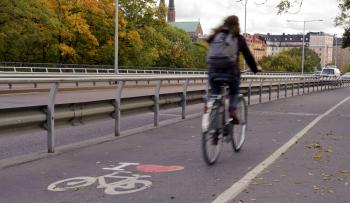
What are SUMPs ?
The European Commission has invested time and energy to promote Sustainable Urban Mobility Plans (SUMPs). This is a new term for what exists in a number of cities already a long time. Since 1996, all French cities with more than 100.000 inhabitants are obliged to develop an Urban Mobility Plan (Plan de Déplacements Urbains –PDU)[1].
The evaluation of 30 years of transport planning shows the effects are visible in large urban areas: there is a decline in car use, increased use of public transport and cycling is recently making a comeback in towns.[2] A good reason for the Commission to promote these kind of plans on a European level.

Key elements of a SUMP
The best thing about SUMPs is their focus on quality of urban life and public spaces in the city, changing back the concentration from traffic & vehicles to people. The goal is to bring urban transport back in balance, after years of unbalanced decisions in favour of motorized transport.
Further objectives of a SUMP are ensure access to key destination and services in the city, enhance safety, reduce pollution and improve efficiency and cost-effectiveness of mobility measures taken.
If there are already existing plans referring to mobility in the city, the goal of a SUMP is to bring these plans together, integrate them (with other policies, services, government levels) and add a participation process and evaluation to it.
From the French experience, it takes minimum 1 year but up to 3 years to prepare a sustainable urban transport plan. The costs to develop a SUMP are between 200.000 and 400.000 EUR.
Want to know more ? http://www.rupprecht-academy.eu/course/index.php?categoryid=15&lang=nl
What’s in it for cycling?
Cycling measures are part of the mix of measures that are recommended in a SUMP. And even if the measures prepared in SUMPs do not directly concern cycle measures, most of them benefit cyclists: eg. access restrictions for private motorized vehicles, traffic calming, mobility plans for workplaces, parking restrictions, etc.
Cyclists’ organisations are also often mentioned as important stakeholders to include in the participation process, preferably at an early stage in the process to help identify problems and then later on to contribute to the development of the objectives and measures. This is something local cyclists’ organisations often gladly contribute to.
What is keeping cities from starting SUMPs?
Already in step 1 of the planning process, a city may encounter the biggest barriers to
- no political will: SUMPs are a good thing and the guidelines full of common sense, but they can easily be shoved to the back of the shelf compared to other priorities (jobs, local economy, industry)
- no budget: If cities do manage to get political support and a budget to develop a SUMP is often a direct consequence. Sometimes there is budget for the planning part, but not for the implementation anymore.
- no data: another barrier they quickly stumble upon is the lack of data. Every SUMP should start with an analysis of the current situation. Unfortunately, many cities only have decent and detailed information about public transport and private motorized vehicles. For freight transport, cycling and walking, the data are either old, not harmonized or completely lacking.
Does the EU refer to SUMPs when attributing large amounts of EU money for transport infrastructure projects? See the presentation of Tom RYE
[1] http://www.territoires-ville.cerema.fr/pdu-the-french-sustainable-urban-mobility-plan-a1454.html
[2] http://www.territoires-ville.cerema.fr/IMG/pdf/1304_Fiche30ansPDU_EN_cle6c8317.pdf
Regions:
News category:
Contact the author
Recent news!
Upcoming events
Contact Us
Avenue des Arts, 7-8
Postal address: Rue de la Charité, 22
1210 Brussels, Belgium









